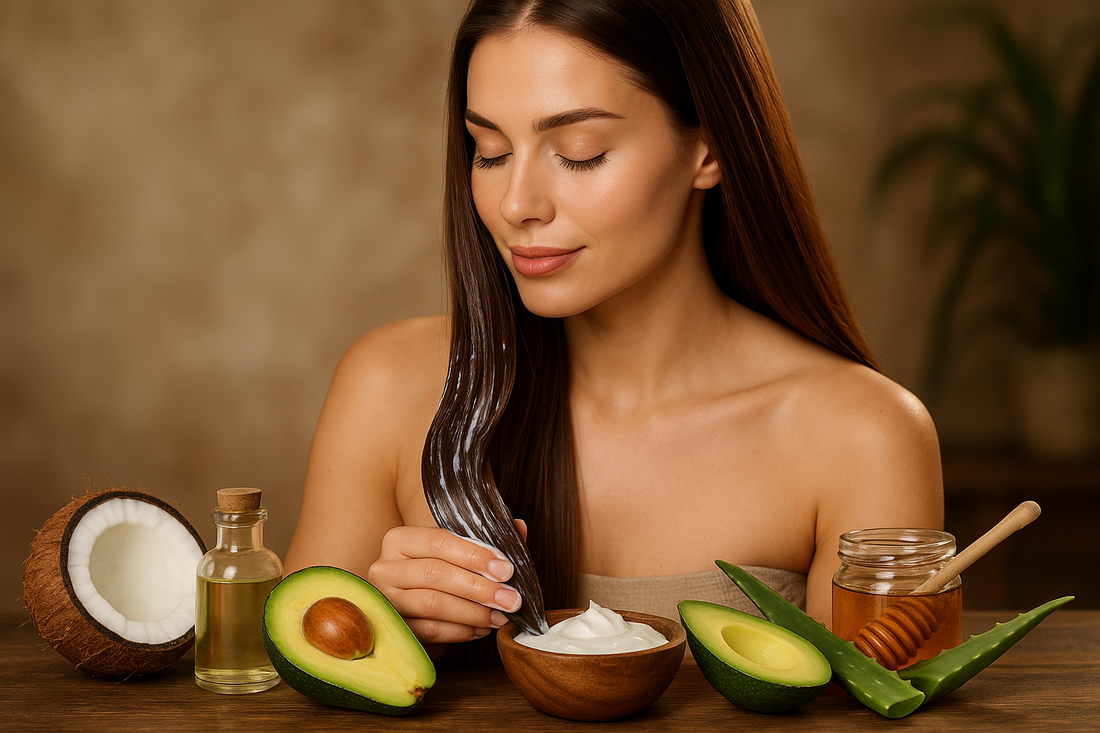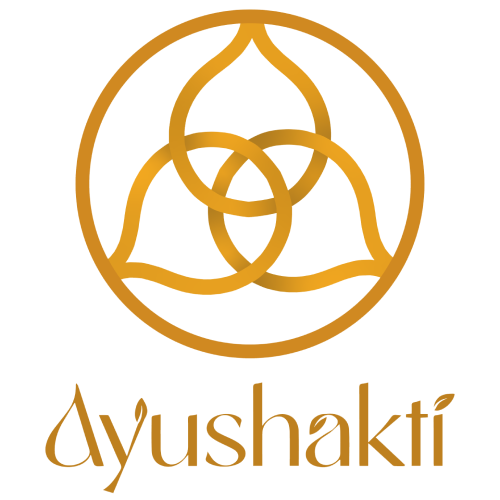
Dry and Damaged Hair? These Hair Masks Work Like Magic!
Share
Beautiful, healthy hair isn’t just about looks — it reflects your overall well-being. Yet, many people today struggle with dry, frizzy, brittle, or damaged hair, often caused by pollution, heat styling, harsh shampoos, stress, or poor nutrition.
While modern science explains hair health through protein, moisture balance, and scalp care, Ayurveda sees hair as a reflection of internal balance — especially of the Vata, Pitta, and Kapha doshas. When these energies are imbalanced, it shows up as dryness, thinning, dandruff, or excessive hair fall.
Let’s explore both the scientific and Ayurvedic approach to restoring your hair’s strength and shine — and some powerful DIY hair masks that truly work like magic!
Understanding Hair from a Scientific Perspective
Hair is primarily made up of a protein called keratin. The health of your hair depends on:
- The scalp condition (how clean, hydrated, and nourished it is)
- Hair follicles (tiny roots that grow new hair strands)
- Nutrients like biotin, iron, zinc, omega fatty acids, and Vitamin C
- Hydration levels within the hair shaft
When hair becomes dry and damaged, it usually means the outer cuticle layer (protective covering) is lifted or broken, causing loss of moisture and nutrients. This leads to:
- Split ends
- Rough texture
- Hair breakage
- Dull and lifeless appearance
Common Causes of Hair Damage
- Excessive heat styling – straighteners, curlers, or blow dryers weaken the cuticle.
- Chemical treatments – hair coloring, bleaching, or keratin treatments can strip natural oils.
- Sun exposure and pollution – UV rays and dust damage the hair shaft.
- Poor diet – lack of essential nutrients like protein, iron, and vitamins.
- Stress – chronic stress can affect hair growth cycles.
Hair and the Three Doshas
- Vata imbalance → causes dryness, frizz, and split ends.
- Pitta imbalance → leads to premature greying, hair fall, and thinning.
- Kapha imbalance → results in oily scalp, dandruff, and sluggish growth.
Ayurveda focuses on balancing these doshas through diet, herbs, oiling, and external treatments like hair masks (Lepa).
Ayurvedic Herbs and Ingredients for Hair Repair
 1. Amla (Indian Gooseberry)
1. Amla (Indian Gooseberry)
Rich in Vitamin C and antioxidants, Amla nourishes hair roots, prevents greying, and adds natural shine.
2. Bhringraj (Eclipta alba)
Known as the “king of herbs for hair,” it strengthens hair follicles, promotes growth, and reduces premature greying.
3. Brahmi (Bacopa monnieri)
Calms the mind, improves scalp circulation, and promotes thicker hair growth.
4. Methi (Fenugreek Seeds)
Rich in protein and iron, it hydrates hair and reduces dandruff.
5. Aloe Vera
Provides deep moisture and soothes scalp irritation.
6. Coconut Oil
A natural conditioner that penetrates the hair shaft, preventing protein loss.
7. Henna
Strengthens hair naturally, adds shine, and cools the scalp.
8. Shikakai & Reetha
Natural cleansers that maintain pH balance and remove buildup without stripping oils.
Top Hair Masks That Work Like Magic
Below are tried and tested Ayurvedic and natural hair masks for dry, frizzy, and damaged hair.
1. Amla & Aloe Vera Hair Mask
For: Dry, dull, and weak hair
Ingredients:
- 2 tbsp Amla powder
- 3 tbsp Aloe Vera gel
- 1 tbsp coconut oil
How to Use:
Mix well into a smooth paste. Apply from roots to tips and leave it on for 30–40 minutes. Rinse with lukewarm water.
Benefits:
Amla boosts collagen and strengthens roots, while aloe vera hydrates the scalp.
2. Methi & Yogurt Hair Mask
For: Frizzy, brittle hair
Ingredients:
- 2 tbsp fenugreek seeds (soaked overnight and ground)
- 3 tbsp yogurt
- 1 tsp olive or sesame oil
How to Use:
Apply evenly on the scalp and hair. Leave it for 45 minutes before rinsing with mild herbal shampoo.
Benefits:
Methi adds protein and shine; yogurt conditions and tames frizz.
3. Banana & Honey Mask
For: Damaged hair with split ends
Ingredients:
- 1 ripe banana
- 2 tbsp honey
- 1 tbsp almond oil
How to Use:
Mash and blend all ingredients. Apply on damp hair, leave for 30 minutes, and rinse thoroughly.
Benefits:
Banana provides deep moisture; honey seals hydration for soft, smooth hair.
4. Brahmi & Bhringraj Herbal Mask
For: Hair fall and weak roots
Ingredients:
- 2 tbsp Brahmi powder
- 2 tbsp Bhringraj powder
- 3 tbsp coconut milk
How to Use:
Mix into a paste and apply gently on the scalp. Leave it for 40 minutes and rinse off.
Benefits:
Strengthens hair follicles, promotes growth, and prevents thinning.
5. Hibiscus & Curry Leaf Hair Mask
For: Hair loss and premature greying
Ingredients:
- 5 hibiscus flowers
- 10 curry leaves
- 3 tbsp coconut oil
How to Use:
Grind into a fine paste. Apply on the scalp for 30–40 minutes. Wash with herbal shampoo.
Benefits:
Boosts melanin production, delays greying, and improves hair thickness.
Dietary and Lifestyle Tips for Healthy Hair (Medical + Ayurvedic)
1. Eat a Hair-Friendly Diet
Include foods rich in:
- Protein: Lentils, paneer, tofu, chickpeas
- Iron: Spinach, beets, jaggery
- Omega-3 fatty acids: Flaxseeds, walnuts
- Vitamin C: Amla, oranges, lemon
- Zinc & Biotin: Whole grains, pumpkin seeds
2. Stay Hydrated
Dehydration makes hair brittle. Aim for 8–10 glasses of water daily.
3. Manage Stress
Ayurveda emphasizes mental calmness for hair growth. Try meditation, yoga, and pranayama to reduce stress-related hair fall.
4. Regular Oil Massage (Abhyanga for Scalp)
Massaging warm herbal oil like Bhringraj or coconut oil improves blood flow and nourishes follicles deeply.
5. Avoid Harsh Chemicals and Heat
Use herbal shampoos, air dry your hair, and protect from pollution and UV exposure.
Detoxification for Hair Health (Ayurvedic Insight)
Sometimes, toxins (Ama) accumulate due to poor digestion or stress, affecting scalp health and hair growth. Ayurvedic therapies can help:
- Shiro Abhyanga (Head Massage): Improves circulation, reduces stress.
- Shirodhara: A calming therapy where warm herbal oil flows gently on the forehead, balancing Pitta and promoting hair growth.
- Nasya: Applying herbal oil drops in the nostrils helps cleanse channels connected to the head and improves scalp nourishment.
Natural Hair Care Routine (Weekly Plan)
| Day | Routine | Ayurvedic Suggestion |
|---|---|---|
| Monday | Hair oil massage | Use coconut or Bhringraj oil |
| Tuesday | Gentle wash | Use Reetha or herbal shampoo |
| Wednesday | Leave-in hydration | Aloe vera gel massage |
| Thursday | Hair mask | Apply Amla & Aloe or Brahmi mask |
| Friday | Scalp detox | Use fenugreek paste |
| Saturday | Rest & yoga | Improves circulation |
| Sunday | Nourishing diet | Include amla juice, ghee, and nuts |
Modern Hair Science Meets Ayurveda
While modern science explains hair in terms of keratin, follicles, and hydration, Ayurveda focuses on root balance — both physical and emotional. A combined approach ensures:
- Stronger roots
- Balanced scalp oils
- Improved shine and growth
- Reduced breakage and premature greying
For regular health tips & updates visit Ayushakti’s Social Media Pages:
- Facebook – Ayushakti Ayurved | Facebook
- Instagram – Ayushakti Ayurved (@ayushakti)
- Pinterest – ayushaktiayurveda
Get all the updates about Ayushakti Ayurved on WhatsApp directly. Click here to Join our WhatsApp Channel
Ayushakti's mission is to help people in every way possible. Our Ayurvedic experts are available to give you a consultation either over the phone or through a video consultation. We recommend customised diets, home remedies, and detox therapies to help you recover from health problems. Book your consultation now!
If you would like to know the location or visit one of our centres, please click here: https://www.ayushakti.com/home/p/contact
For more information, write to us at info@ayushakti.com or call our toll-free numbers: 18002663001 (India) and +18002800906 (Global).
Blog Author: Dr. Ramchandra Konduskar
Expert Review: Dr Smita Pankaj Naram
Co-Founder, Ayushakti Ayurved Pvt Ltd
Disclaimer: This blog is for educational purposes only. Please consult an Ayurvedic practitioner before trying or consuming any medicines, home remedies or treatments mentioned in this blog. The information provided is not intended to diagnose, treat, cure, or prevent any disease.





